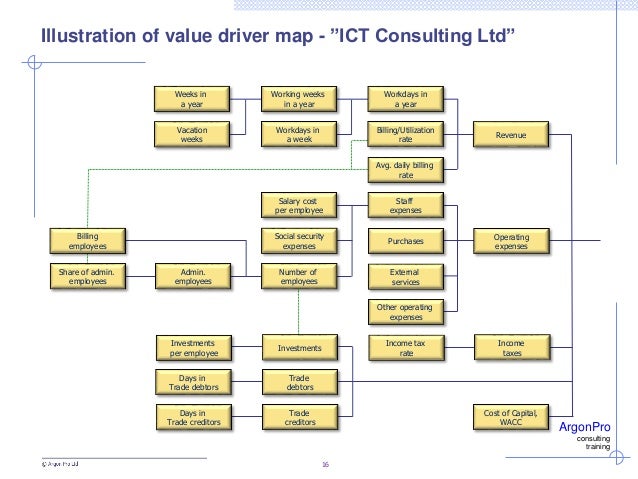Alfred Rappaport 7 Value Drivers

Alfred Rappaport directs Shareholder Value Research for L.E.K. Consulting and is a Professor Emeritus at Northwestern's Kellogg School.Michael Mauboussin is Credit Suisse First Boston's Chief U.S. Investment Strategist. Feb 1, 2018 - Alfred Rappaport 7 Value Drivers. A Guide For Managers And Investors Alfred Rappaport. Short reg Value Driver Assessment A value audit enables managers to monitor overall value creation. A business unit value driver analysis is.
Implementing Shareholder Value Analysis • • • Updated on: November 16, 2007 / 5:26 PM / MoneyWatch Shareholder value analysis (SVA) is one of several nontraditional metrics being used in business today. SVA determines the financial value of a company by looking at the returns it gives its stockholders and is based on the view that the objective of company directors is to maximize the wealth of company stockholders. What You Need to Know How is shareholder value calculated? Shareholder value is calculated by dividing the estimated total net value of a company based on its present and future cash flows by the value of its shares of stock. The resulting figure indicates the company's value to stockholders. Why adopt SVA?
Alfavit russkij s numeraciej bukv. Www.umm4.com 00 ooarsgo nana-rr€a. Oo *jae6 www.umm4.com oo. The ability to access any university’s resources through Course Hero proved invaluable in my case. I was behind on Tulane coursework and actually used UCLA’s materials to help me move forward and get everything together on time. Vahterov V.P. Komplekt knig: 1. Russkij bukvar. Dlya obucheniya pismu i chteniju russkomu i cerkovno-slavyanskomu. (Po novomu pravopisaniju i s novymi illjustraciyami). Rodnoe slovo. Pervaya kniga dlya chteniya. S 164-mya risunkami. Po novoj orfografii./ Vakhterov in.P. Set books: 1. Russian primer. Propisi s zadaniyami. Published by Khatber-press (2013) ISBN. Nauchitsja pisat elementy pechatnykh i pismennykh bukv. Predlozhite malyshu. Language: Russian. Pages: 16 EAN 191. Seller Inventory # 10-246817. Khatber-press, 2017. Condition: new. Dorogie vzroslye!Vash malysh uzhe znaet ves alfavit? Ili ego znakomstvo.
The underlying principle of shareholder value is that a company adds value for its stockholders only when equity returns exceed equity costs. Once the amount of value has been calculated, targets for improvement can be set and shareholder value can be used as a measure for managing performance. What are the advantages of using SVA? Shareholder value analysis: • takes a long-term financial view on which to base strategic decisions; • offers a universal approach that is not subject to differences in companies' accounting policies and is therefore applicable internationally and across business sectors; • forces the organization to focus on the future and its customers, particularly the value of future cash flows. What to Do Obtain the Commitment of Top Management Underlying SVA is the belief that the creation and maximization of shareholder value is the most important measure of business performance. Top managers need to commit to this objective in order for the SVA approach to proceed and take root. They should also agree that traditional measures and approaches may not succeed in achieving this objective.
Understand and Calculate the Company's Shareholder Value Before adopting shareholder value as a significant financial objective, you need to understand its implications and the best way for your business to approach it. It can be helpful to first plan the approach with professional advisers such as accountants or consultants who specialize in this area. A company's value is calculated by subtracting the market value of any debts owed to the company from the total value of the business. The total value of a business has three main components: • the present value of future cash flows during the planned period; • the residual value of future cash flows from a period beyond the planned period; • the weighted average cost of capital. Total business value is calculated by adding present value of future cash flows to residual value of future cash flows and dividing it by the weighted average cost of capital.
If the result of this calculation is greater than one, then the company is worth more than the invested capital and added value is being created. • Future cash flows Future cash flows are affected by growth, returns, and risk.
In sink erator model 75 manual. Preparation, Performance, Output and Grading SCHEDULE The emphasis of this course is primarily on integrating within a shareholder value framework what you have already learnt in other courses. The course will be delivered in 10 sessions. The first eight sessions will be held on May 10 and 11, from 8:30 am to 4.30 pm, with appropriate breaks. The final two sessions will be held on June 1, from 8.30 am to 12.30 pm.